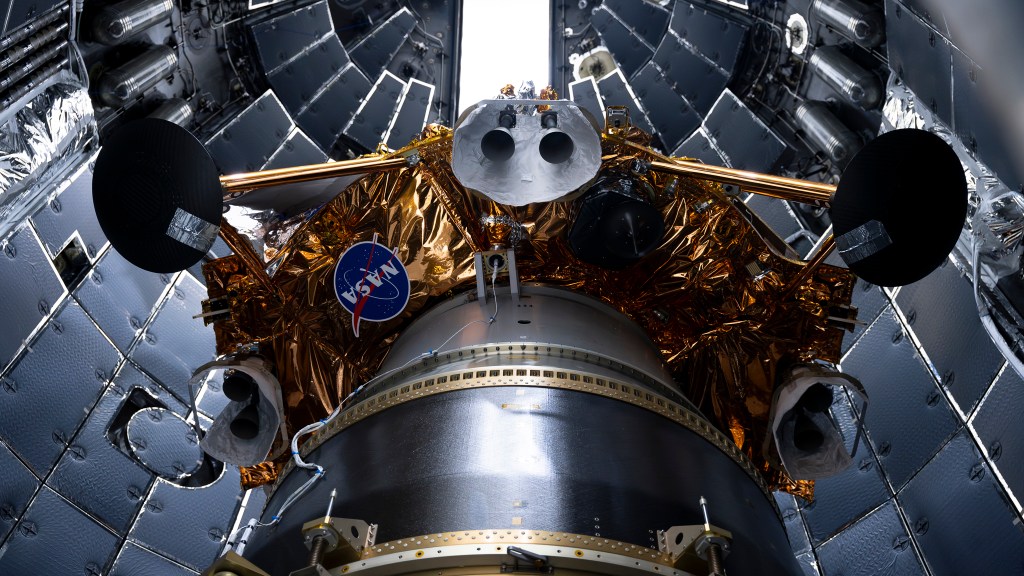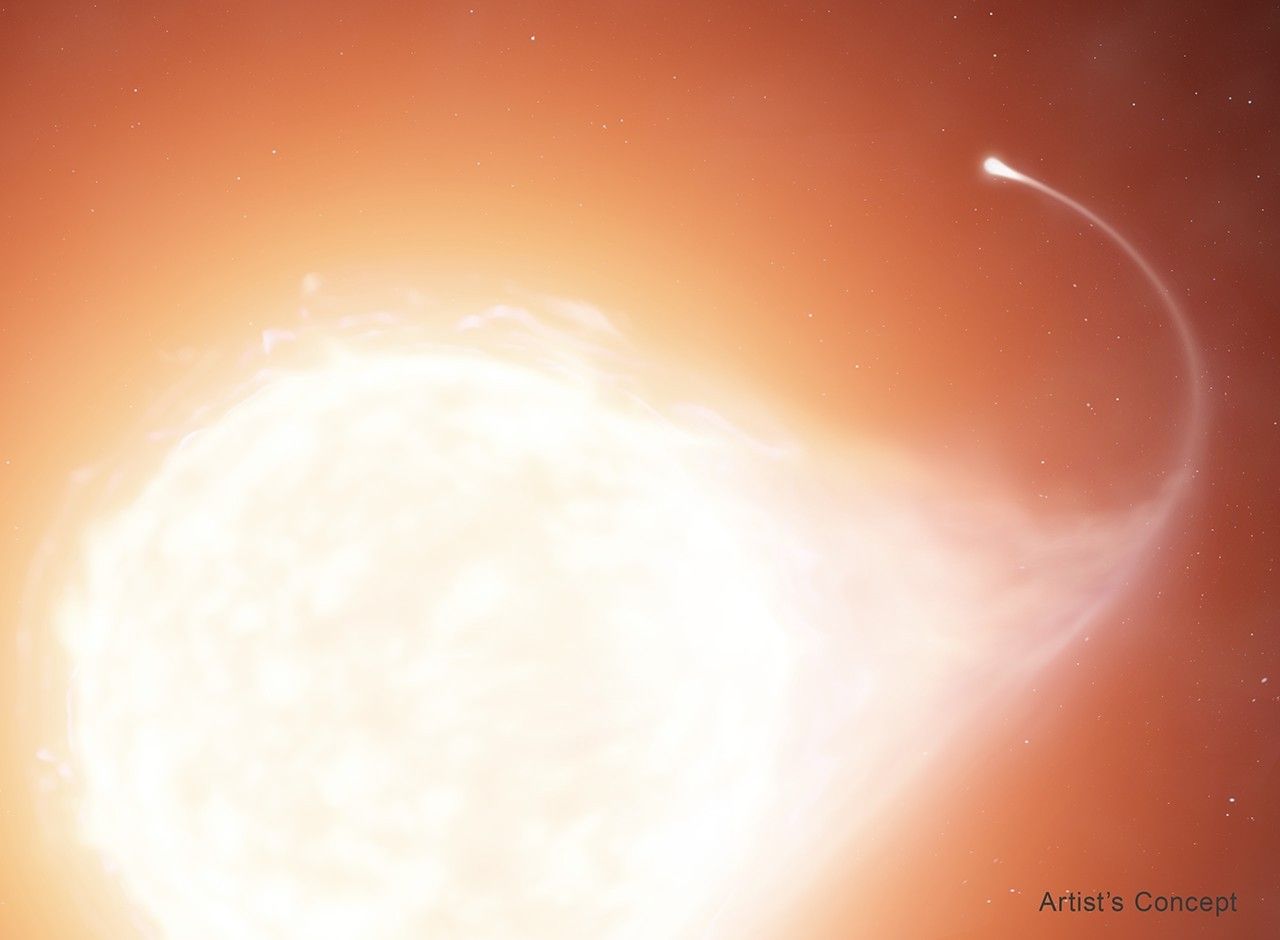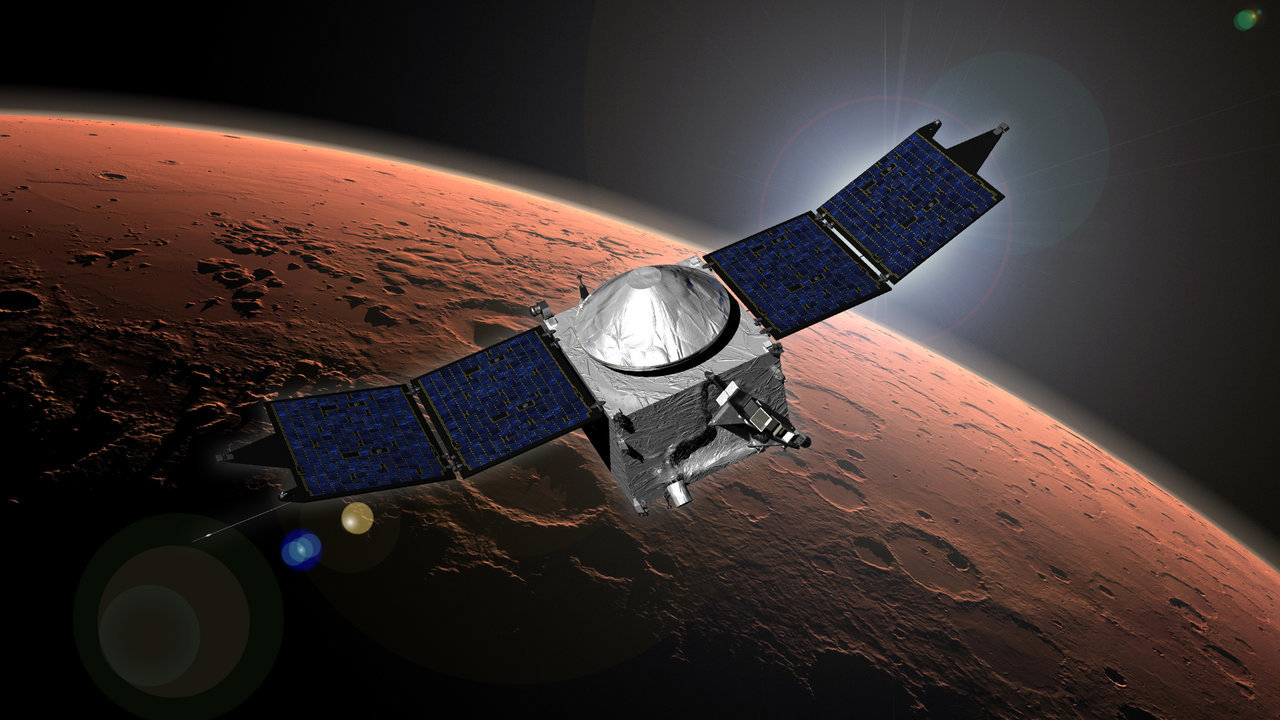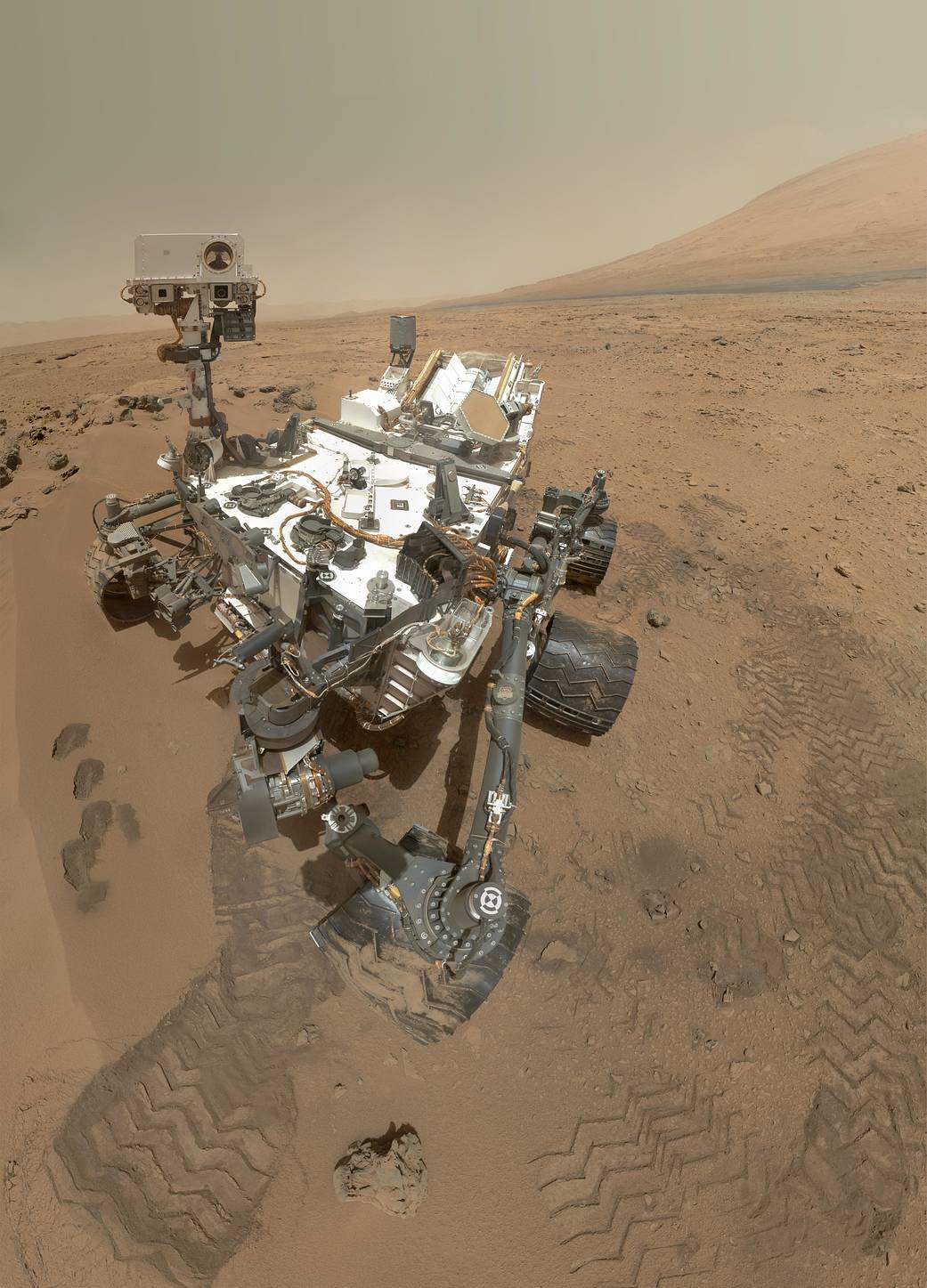When the Mars Atmosphere and Volatile Evolution, or MAVEN, spacecraft arrived at the Red Planet on Sept. 21, it marked the continuation of exploration of one of Earth’s nearest celestial neighbors that began 50 years ago. In 1964, the Mariner 4 probe became the first to successfully fly by Mars, opening the way for future human exploration.
MAVEN was launched from the Kennedy Space Center atop an Atlas V rocket on Nov. 18, 2013. Following a roughly 10-month trip of over 442 million miles, the spacecraft was inserted into an elliptical orbit on Sept. 21.
MAVEN will study the Martian upper atmosphere while orbiting the planet. Mission goals include determining how the Martian atmosphere and water, presumed to have once been substantial, were lost over time. Spacecraft previously visiting Mars returned data indicating that liquid water once flowed on the Mars surface. However, water now cannot exist extensively on the Martian surface due to the low atmospheric pressure and surface temperatures. MAVEN will observe the upper atmosphere, and drivers of variability from the Sun, in order to estimate the loss of the Martian atmosphere and water over time.
The primary mission includes five “deep-dip” campaigns in which MAVEN’s lowest orbital altitude will be from 93 miles to about 77 miles. These measurements will provide information at the point where the upper and lower atmospheres meet, giving scientists a full profile of the upper tier.
“NASA has a long history of scientific discovery at Mars and the safe arrival of MAVEN opens another chapter,” said John Grunsfeld, astronaut and associate administrator of the NASA Science Mission Directorate at the agency’s Headquarters in Washington. “MAVEN will complement NASA’s other Martian robotic explorers — and those of our partners around the globe — to answer some fundamental questions about Mars and life beyond Earth.”
The exploration of Mars began a half-century ago with the Nov. 28, 1964, launch of Mariner 4, the first successful mission to the Red Planet. It was one of the great early successes for NASA, returning the first photographs of another planet from deep space.
Approximately 40 minutes prior to closest approach on July 15, 1965, at a range of 6,118 miles, the television camera began taking the first of 21 photographs.

A report by the Jet Propulsion Laboratory-California Institute of Technology team that managed the flight stated that the surface was pock-marked much like the moon.
“There were more than 70 clearly distinguishable craters ranging in diameter from 4 to 120 km (2.5 to 74.5 miles),” the report said. “It seems likely that smaller craters exist; there also may be still larger craters, since Mariner 4 photographed, in all, about one percent of the Martian surface.”
A little more than an hour after the encounter, Mariner 4 dipped behind Mars, as viewed from Earth, in order to refract its radio signals through the Martian atmosphere. Data indicated that the atmospheric pressure on the surface was quite low.
The probe detected daytime surface temperatures of about minus 148 degrees Fahrenheit. A very weak radiation belt, about 0.1 percent that of the Earth’s, was also discovered by Mariner 4.
In addition to unlocking key information about how to safely deliver future missions to the Martian surface, the spacecraft far outlasted its planned eight-month mission. Mariner 4 remained in solar orbit, continuing long-term studies of the solar wind and making coordinated measurements with the Mariner 5 mission to Venus. Contact was finally lost on Dec. 21, 1967.
Since Mariner 4, the lure of the Red Planet remains, with numerous spacecraft being launched to further explore Mars by the United States, the Soviet Union/Russia, Japan, Great Britain, the European Space Agency, India and the People’s Republic of China. MAVEN makes the 16th successful American probe dispatched to Mars.
On Nov. 13, 1971, Mariner 9 became the first spacecraft to be placed in orbit around another planet. After enduring months of dust storms, Mariner 9 sent back clear pictures of the Martian surface.
Vikings 1 and 2 were the first spacecraft to soft land on Mars and to successfully perform a mission returning data and photographs of the landscape. Viking 1 once held the record for the longest Mars surface mission of 2,307 days or 2,245 sols (Martian days). The record was broken by the Opportunity Rover on May 19, 2010. The term “sol” refers to the duration of a solar day on Mars, equal to 24 hours and 39 minutes on Earth.
NASA’s Mars Pathfinder landed a base station with a roving probe on Mars on July 4, 1997. The 23-pound wheeled robotic Mars rover, named Sojourner, made measurements of the elements found in the rocks and the Martian soil.
Among the most successful robotic explorers have been the twin Mars Exploration Rovers, known as Spirit and Opportunity. The rovers were designed to search for and characterize a wide range of rocks and soils that hold clues to past water activity on Mars.
Mission planners initially hoped the two rovers would operate for 90 sols. After that time, both Spirit and Opportunity still had plenty of life, and multiple mission extensions kept Spirit functioning until March 22, 2010. Opportunity continues to operate, having traveled almost 25 miles across the Martian surface.
Launched by NASA to Mars on Nov. 26, 2011, the Mars Science Laboratory (MSL) landed the Curiosity rover on Aug. 6, 2012. The compact car-sized rover is about twice as long and five times as heavy as Spirit and Opportunity and carries over ten times the mass of scientific instruments.
MSL carried out a more accurate landing than previous spacecraft to Mars, aiming for a small target landing ellipse of only 4.3 by 12.4 miles, in the 96-mile-diameter Gale Crater. Curiosity now is investigating Mars’ habitability, studying its climate and geology and collecting data in advance of a human expedition to the Red Planet.
The MSL Curiosity rover measured radiation on the way to Mars and is sending back data that will help in planning how to protect astronauts who travel to Mars.
Since Mariner 4’s arrival in 1965, a fleet of robotic spacecraft and rovers has landed on and orbited Mars. Collectively, they have dramatically increased the knowledge-base about the Red Planet, helping pave the way for future human explorers.
For many years, science fiction writers told fanciful stories about encounters with Martians. However, the first detailed study of the engineering challenges of an actual trip to the Red Planet was published by Wernher von Braun in his 1952 book, The Mars Project.
Von Braun began writing the manuscript in 1947 while working for the U.S. Army at Fort Bliss, in El Paso, Texas. At the time, he was helping launch rockets to the edge of space at the nearby White Sands Proving Ground in New Mexico.
In his book, von Braun suggested that a mission to Mars would require a fleet of spacecraft, noting that when Christopher Columbus sailed from Spain in 1492, it was with three ships.
“So it is with interplanetary exploration,” he wrote, “it must be done on a grand scale.”
American television audiences gained their first view of the possibility of human space travel in a series of episodes of Walt Disney’s popular show, Disneyland. Between 1955 and 1957, Disney presented what he called “science factual” episodes, including one entitled “Mars and Beyond.”
“Together, von Braun (the engineer) and Disney (the artist) used the new medium of television to illustrate how high man might fly on the strength of technology and the spirit of human imagination,” wrote Mike Wright, the Marshall Space Flight Center’s historian, in an article on the Disney and von Braun’s collaboration.

NASA’s Orion spacecraft and Space Launch System (SLS) rocket are designed to achieve that goal to expand human presence in deep space and enable exploration of new destinations in the solar system.
Orion is intended to meet the evolving needs of our nation’s space program for decades to come. It will take crews of up to four astronauts farther than they’ve ever gone before, enabling missions to asteroids and, eventually, to Mars.
Scheduled for December, the upcoming Exploration Flight Test 1, or EFT-1, will be the first test flight for Orion.
NASA’s SLS, a heavy-lift launch vehicle that will help provide that new capability for human exploration, will boost Orion off the planet in the first integrated flight test, Exploration Mission 1. SLS is designed to be flexible, launching spacecraft for both human and cargo missions.
One of the first steps to develop the “grand scale” technology needed for such an expedition will come from NASA’s initiative to use advanced solar electric propulsion to robotically capture an asteroid and redirect it to a stable orbit in the Earth-moon system. Astronauts then would launch aboard an Orion spacecraft atop an SLS rocket to collect samples of and explore the relocated asteroid.
NASA Administrator Charles Bolden believes that the latest spacecraft to arrive at Mars, along with those that preceded it, are the stepping stones needed to reach the ultimate goal of human exploration.
“As the first orbiter dedicated to studying Mars’ upper atmosphere, MAVEN will greatly improve our understanding of the history of the Martian atmosphere, how the climate has changed over time, and how that has influenced the evolution of the surface and the potential habitability of the planet,” Bolden said. “It also will better inform a future mission to send humans to the Red Planet in the 2030s.”

































